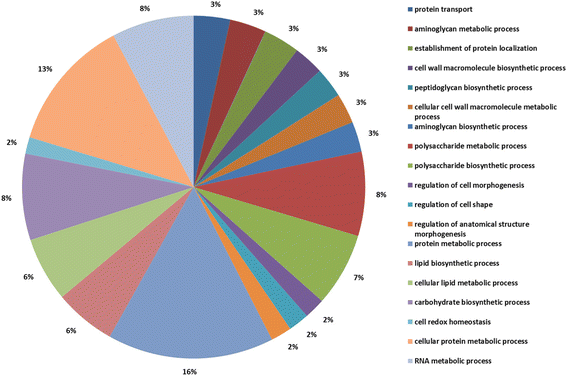Genetic engineering of Escherichia coli to improve L-phenylalanine production
- PMID: 29382315
- PMCID: PMC5791370
- DOI: 10.1186/s12896-018-0418-1
Genetic engineering of Escherichia coli to improve L-phenylalanine production
Abstract
Background: L-phenylalanine (L-Phe) is an essential amino acid for mammals and applications expand into human health and nutritional products. In this study, a system level engineering was conducted to enhance L-Phe biosynthesis in Escherichia coli.
Results: We inactivated the PTS system and recruited glucose uptake via combinatorial modulation of galP and glk to increase PEP supply in the Xllp01 strain. In addition, the HTH domain of the transcription factor TyrR was engineered to decrease the repression on the transcriptional levels of L-Phe pathway enzymes. Finally, proteomics analysis demonstrated the third step of the SHIK pathway (catalyzed via AroD) as the rate-limiting step for L-Phe production. After optimization of the aroD promoter strength, the titer of L-Phe increased by 13.3%. Analysis of the transcriptional level of genes involved in the central metabolic pathways and L-Phe biosynthesis via RT-PCR showed that the recombinant L-Phe producer exhibited a great capability in the glucose utilization and precursor (PEP and E4P) generation. Via systems level engineering, the L-Phe titer of Xllp21 strain reached 72.9 g/L in a 5 L fermenter under the non-optimized fermentation conditions, which was 1.62-times that of the original strain Xllp01.
Conclusion: The metabolic engineering strategy reported here can be broadly employed for developing genetically defined organisms for the efficient production of other aromatic amino acids and derived compounds.
Keywords: AroD; L-phenylalanine; Metabolic engineering; Proteomics; TyrR.
Conflict of interest statement
Ethics approval and consent to participate
Not applicable.
Consent for publication
Not applicable.
Competing interests
The authors declare that they have no competing interests
Publisher’s Note
Springer Nature remains neutral with regard to jurisdictional claims in published maps and institutional affiliations.
Figures








Similar articles
-
Phosphoenolpyruvate:glucose phosphotransferase system modification increases the conversion rate during L-tryptophan production in Escherichia coli.J Ind Microbiol Biotechnol. 2017 Oct;44(10):1385-1395. doi: 10.1007/s10295-017-1959-3. Epub 2017 Jul 19. J Ind Microbiol Biotechnol. 2017. PMID: 28726163
-
Application of Dynamic Regulation to Increase L-Phenylalanine Production in Escherichia coli.J Microbiol Biotechnol. 2019 Jun 28;29(6):923-932. doi: 10.4014/jmb.1901.01058. J Microbiol Biotechnol. 2019. PMID: 31154747
-
Improvement of L-phenylalanine production from glycerol by recombinant Escherichia coli strains: the role of extra copies of glpK, glpX, and tktA genes.Microb Cell Fact. 2014 Jul 11;13(1):96. doi: 10.1186/s12934-014-0096-1. Microb Cell Fact. 2014. PMID: 25012491 Free PMC article.
-
Inactivation of the PTS as a Strategy to Engineer the Production of Aromatic Metabolites in Escherichia coli.J Mol Microbiol Biotechnol. 2015;25(2-3):195-208. doi: 10.1159/000380854. Epub 2015 Jul 9. J Mol Microbiol Biotechnol. 2015. PMID: 26159079 Review.
-
From scratch to value: engineering Escherichia coli wild type cells to the production of L-phenylalanine and other fine chemicals derived from chorismate.Appl Microbiol Biotechnol. 2007 Jun;75(4):739-49. doi: 10.1007/s00253-007-0931-y. Epub 2007 Apr 14. Appl Microbiol Biotechnol. 2007. PMID: 17435995 Review.
Cited by
-
Metabolic engineering for the production of l-phenylalanine in Escherichia coli.3 Biotech. 2019 Mar;9(3):85. doi: 10.1007/s13205-019-1619-6. Epub 2019 Feb 15. 3 Biotech. 2019. PMID: 30800596 Free PMC article. Review.
-
Natural and engineered cyclodipeptides: Biosynthesis, chemical diversity, and engineering strategies for diversification and high-yield bioproduction.Eng Microbiol. 2022 Dec 24;3(1):100067. doi: 10.1016/j.engmic.2022.100067. eCollection 2023 Mar. Eng Microbiol. 2022. PMID: 39628525 Free PMC article. Review.
-
Introduction of a phenylalanine sink in fast growing cyanobacterium Synechococcus elongatus PCC 11801 leads to improved PSII efficiency, linear electron transport, and carbon fixation.Plant J. 2025 Apr;122(2):e70129. doi: 10.1111/tpj.70129. Plant J. 2025. PMID: 40305870 Free PMC article.
-
In silico model-guided identification of transcriptional regulator targets for efficient strain design.Microb Cell Fact. 2018 Oct 25;17(1):167. doi: 10.1186/s12934-018-1015-7. Microb Cell Fact. 2018. PMID: 30359263 Free PMC article.
-
Optimization of Cephalosporin C Acylase Expression in Escherichia coli by High-Throughput Screening a Constitutive Promoter Mutant library.Appl Biochem Biotechnol. 2021 Apr;193(4):1056-1071. doi: 10.1007/s12010-020-03482-9. Epub 2021 Jan 6. Appl Biochem Biotechnol. 2021. PMID: 33405008
References
Publication types
MeSH terms
Substances
LinkOut - more resources
Full Text Sources
Other Literature Sources
Miscellaneous

